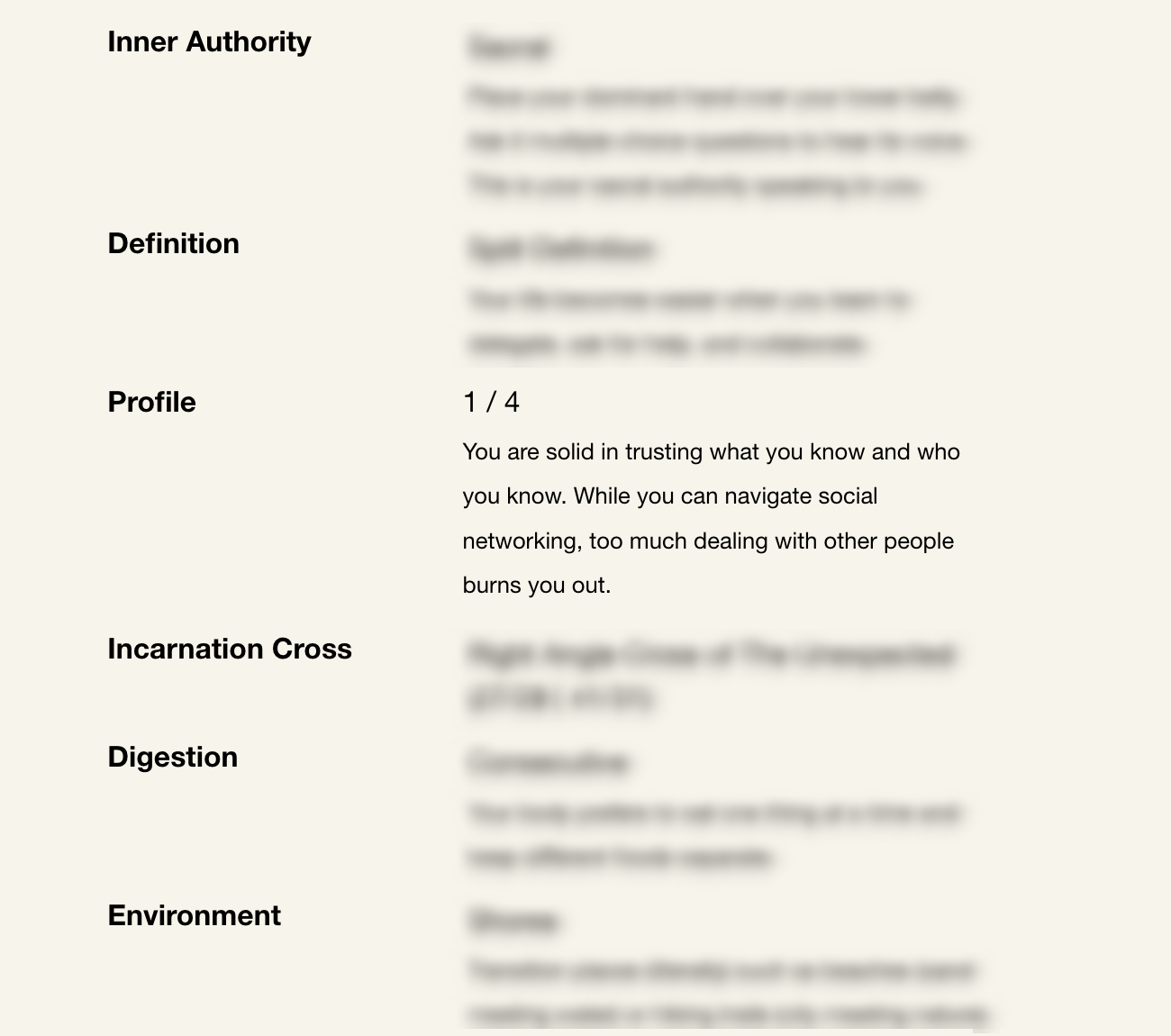The 1/4 Human Design Investigator Opportunist
In Human Design, you have something called the “profile.” This is the closest thing you can get to an archetype which gives you a list of traits commonly associated with your profile.
Your profile makes up 70% of your Human Design.
This blog post is written through the perspective that we’re looking at children. Children don’t have enough life experience to have the conditioning that adults do. Using the perspective of children helps see the default state before a person has been told to “be more extraverted” or “step up and be a leader.”
Adults have a tendency to cope in order to survive in this world. For example, if you were taught to be more aggressive to get what you want, you may feel it’s inaccurate to know you’re designed to keep to yourself.
This is why we’re looking you as a child.
To find your profile, generate your Human Design chart.
In the middle, you’ll find your profile.
The 1/4 child, aka the transmitter
The 1/4 child can enjoy being locked in their room for [any given amount of time] before coming out and appearing social. When they come out, they usually have something to share- a discovery, a revelation, an understanding that they’re excited to confide in you.
Having a 1/4 share their soul is special. Of all profiles, the 1/4 yearns the most for safety.
They need to feel secure in what they know and who they share knowledge with.
These kids may identify with the “introverted extravert” because of how they isolate and then reintegrate back into social life. However, they’re not built to socialize long-term. They become exhausted when they spend too much outside of their comfort space.
Their sense of security is rooted in what and who they know; they don’t have to explain why.
For example, I need to sleep without any mirrors or open closet doors in my room. There’s something creepy about it. A child who does the opposite comes off strange to me. They may be unable to explain why (even if they do, I won’t understand), but they don’t have to. If they feel good about it, that’s the end of the story.
The 1/4 is built to share, not explain. Note that this is just looking at the profile. Anyone could have elements of a chart that builds them to explain, but the 1/4 alone will not express that.
Another example is if the 1/4 teenager drinks a dozen eggs every morning. You may ask, “Do you like it?” All they have to say is “yes” or “no.” It’s on them if they want to explain why.
The ‘1’ Investigator in 1/4 Investigator Opportunist
The ‘1’ in 1/4 is the Investigator.
When these people want to know something, they lock themselves in libraries, Google searches, and any research methods. They have a process; pulling them out is difficult and not recommended.
The 1/4 doesn’t work alone, but the ‘1’ in 1/4 does. They will approach others to ask for information instead of taking unsolicited advice. They are satisfied if they can understand their research rather than knowing how to explain it or teach it to others.
They’re not receptive to unsolicited advice. For example, if a dish is cooked to their liking, they won’t listen to someone sharing it. It could be done better.
If you have a child with a ‘1’ in their profile, they may struggle with doing things “your way” versus the way that makes sense to them.
They are also thorough people. They are well-read and well-researched and strive to see all sides of an argument because they know this is the only way to truly understand.
The ‘4’ in 1/4 Investigator Martyr
The ‘4’ is the Opportunist.
These people are “the guys who always know a guy.” Through natural networking, they can find opportunities for themselves and others.
This networking is rooted in feeling safe around other people. Referral marketing and having personal overlap with professional social circles is common for the ‘4'. They would rather refer you to a close friend who does great, consistent work than vouch for a well-known face with whom they don’t have personal or comfortable interaction.
Their methodology is based on trust.
They also prefer sharing their findings with people who would appreciate their voice. The ‘1’ in 1/4 is the thorough researcher. The ‘4’ determines who can benefit from that research and shares it with those people. Those people give the 1/4 mutual respect.
This is how the 1/4 takes what they know and ‘transmits’ it to others.
Look into a 1/4’s life: Emily Dickinson
Emily Dickinson is likely a 1/4 Emotional Projector. Her birth time is documented in a biography, but no birth certificates have confirmed that birth time.
Emily Dickinson was known for being a homebody. She enjoyed spending her time in her garden or alone in her writing. She also spent most of her life in a brick family home built by her grandfather, Samuel Fowler Dickinson. Perhaps she felt safe there. It’s known that she’s close to her family.
The 1/4 in her chart could’ve manifested in being reclusive in her room and family home while sharing her introspections with those she felt safe with. For example, she wrote letters to loved ones, most notably her sister-in-law, Susan Gilbert Dickinson (Dollie).
“You love me—you are sure—
I shall not fear mistake—
I shall not cheated wake—
Some grinning morn—
To find the Sunrise left—
And Orchards—unbereft—
And Dollie—gone!
I need not start—you're sure—
That night will never be—
When frightened—home to Thee I run—
To find the windows dark—
And no more Dollie—mark— Quite none?
Be sure you're sure—you know—
I'll bear it better now—
If you'll just tell me so—
Than when—a little dull Balm grown—
Over this pain of mine—
You sting—again!”
- Emily Dickinson


